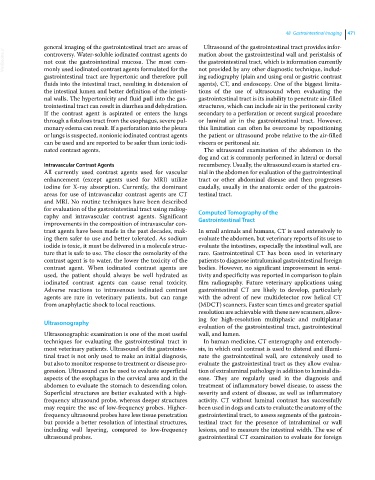Page 503 - Clinical Small Animal Internal Medicine
P. 503
48 Gastrointestinal Imaging 471
general imaging of the gastrointestinal tract are areas of Ultrasound of the gastrointestinal tract provides infor
VetBooks.ir controversy. Water‐soluble iodinated contrast agents do mation about the gastrointestinal wall and peristalsis of
the gastrointestinal tract, which is information currently
not coat the gastrointestinal mucosa. The most com
monly used iodinated contrast agents formulated for the
ing radiography (plain and using oral or gastric contrast
gastrointestinal tract are hypertonic and therefore pull not provided by any other diagnostic technique, includ
fluids into the intestinal tract, resulting in distension of agents), CT, and endoscopy. One of the biggest limita
the intestinal lumen and better definition of the intesti tions of the use of ultrasound when evaluating the
nal walls. The hypertonicity and fluid pull into the gas gastrointestinal tract is its inability to penetrate air‐filled
trointestinal tract can result in diarrhea and dehydration. structures, which can include air in the peritoneal cavity
If the contrast agent is aspirated or enters the lungs secondary to a perforation or recent surgical procedure
through a fistulous tract from the esophagus, severe pul or luminal air in the gastrointestinal tract. However,
monary edema can result. If a perforation into the pleura this limitation can often be overcome by repositioning
or lungs is suspected, nonionic iodinated contrast agents the patient or ultrasound probe relative to the air‐filled
can be used and are reported to be safer than ionic iodi viscera or peritoneal air.
nated contrast agents. The ultrasound examination of the abdomen in the
dog and cat is commonly performed in lateral or dorsal
Intravascular Contrast Agents recumbency. Usually, the ultrasound exam is started cra
All currently used contrast agents used for vascular nial in the abdomen for evaluation of the gastrointestinal
enhancement (except agents used for MRI) utilize tract or other abdominal disease and then progresses
iodine for X‐ray absorption. Currently, the dominant caudally, usually in the anatomic order of the gastroin
areas for use of intravascular contrast agents are CT testinal tract.
and MRI. No routine techniques have been described
for evaluation of the gastrointestinal tract using radiog Computed Tomography of the
raphy and intravascular contrast agents. Significant Gastrointestinal Tract
improvements in the composition of intravascular con
trast agents have been made in the past decades, mak In small animals and humans, CT is used extensively to
ing them safer to use and better tolerated. As sodium evaluate the abdomen, but veterinary reports of its use to
iodide is toxic, it must be delivered in a molecule struc evaluate the intestines, especially the intestinal wall, are
ture that is safe to use. The closer the osmolarity of the rare. Gastrointestinal CT has been used in veterinary
contrast agent is to water, the lower the toxicity of the patients to diagnose intraluminal gastrointestinal foreign
contrast agent. When iodinated contrast agents are bodies. However, no significant improvement in sensi
used, the patient should always be well hydrated as tivity and specificity was reported in comparison to plain
iodinated contrast agents can cause renal toxicity. film radiography. Future veterinary applications using
Adverse reactions to intravenous iodinated contrast gastrointestinal CT are likely to develop, particularly
agents are rare in veterinary patients, but can range with the advent of new multidetector row helical CT
from anaphylactic shock to local reactions. (MDCT) scanners. Faster scan times and greater spatial
resolution are achievable with these new scanners, allow
ing for high‐resolution multiphasic and multiplanar
Ultrasonography
evaluation of the gastrointestinal tract, gastrointestinal
Ultrasonographic examination is one of the most useful wall, and lumen.
techniques for evaluating the gastrointestinal tract in In human medicine, CT enterography and enterocly
most veterinary patients. Ultrasound of the gastrointes sis, in which oral contrast is used to distend and illumi
tinal tract is not only used to make an initial diagnosis, nate the gastrointestinal wall, are extensively used to
but also to monitor response to treatment or disease pro evaluate the gastrointestinal tract as they allow evalua
gression. Ultrasound can be used to evaluate superficial tion of extraluminal pathology in addition to luminal dis
aspects of the esophagus in the cervical area and in the ease. They are regularly used in the diagnosis and
abdomen to evaluate the stomach to descending colon. treatment of inflammatory bowel disease, to assess the
Superficial structures are better evaluated with a high severity and extent of disease, as well as inflammatory
frequency ultrasound probe, whereas deeper structures activity. CT without luminal contrast has successfully
may require the use of low‐frequency probes. Higher‐ been used in dogs and cats to evaluate the anatomy of the
frequency ultrasound probes have less tissue penetration gastrointestinal tract, to assess segments of the gastroin
but provide a better resolution of intestinal structures, testinal tract for the presence of intraluminal or wall
including wall layering, compared to low‐frequency lesions, and to measure the intestinal width. The use of
ultrasound probes. gastrointestinal CT examination to evaluate for foreign

